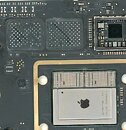Monday, April 5th 2021

Engineers Upgrade Soldered Components on Apple M1 Mac Mini
The Apple M1 processor features integrated memory directly on the chip to reduce latency, power, and size. While this design may be good for the overall user experience it does not bode well for upgradability requiring users to pay up for a more expensive model. Some Chinese engineers have recently shown how it is possible to upgrade the soldered memory and storage components given you have the time, skills, and money. The DRAM and NAND chips are soldered to the M1 chip and motherboard but can be removed and replaced with higher capacity chips using a specialty soldering station. The engineers upgraded the base model M1 Mac Mini with 8 GB RAM and 256 GB storage to 16 GB RAM and 1 TB storage. The upgrade didn't require firmware modifications according to the source which is very impressive if true.
Source:
@duanrui1205



16 Comments on Engineers Upgrade Soldered Components on Apple M1 Mac Mini
I'm all for it and think this sort of thing is what we need from Nvidia and AMD right now. I'm sure they could have some kind of buy back/salvage deal with big crypto miners to take back cards once they are no longer in that perfect efficiency curve to be profitable, and salvage the gpu and memory (after validation) for new boards they can sell with a warranty. All those old p106 mining cards with no video outputs could become gtx 1060s.
those cards are still value today.
I just think its a reasonable idea to embrace. Nvidia and AMD can take their latest and greatest silicon and put it in the hands of miners first and have the gpu, memory, and vrms designed and tuned for mining efficiency. The only other guys paying mining prices right now are the professional compute guys with Teslas and and Quadros - and they already get silicon tuned for certain targets (Tesla T4 gets RTX 2070 super shader/tensor count but at a third the clock speed and on a half height/single slot card). Just create the eco system where last gens compute silicon becomes this gen's gaming silicon. If miners and big tensor guys want to pay nvidia 10X what gamers will pay for the latest and greatest thats fine. Reality most gamers are going to be happy with a 1080 they could get for $250. It doesnt matter that the silicon itself came out in 2016, as long as the rest of the card still works so will that GP104.
And still, 90% of it is to lock user upgradability.
Near single digit yield sounds bit odd